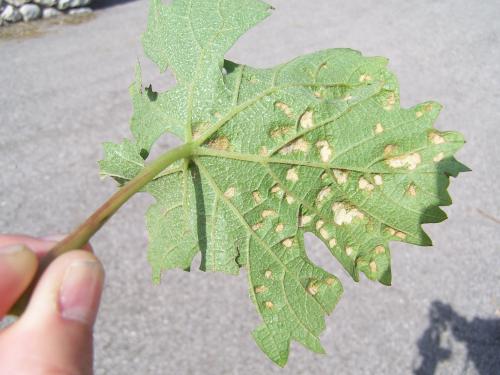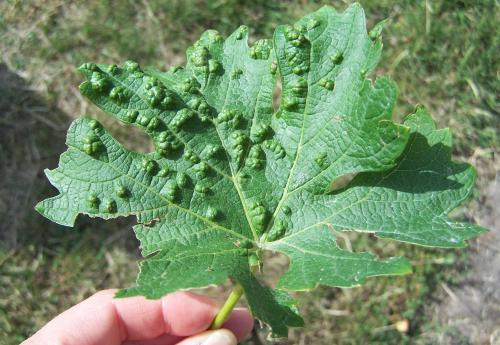Grape erineum management opportunity at dormant timing
Horticultural oil application can suppress early mite development.
The grape erineum mite has been increasing in abundance in some Michigan vineyards, particularly in the northern production regions. Infestation is very patchy, only in some cultivars within a block, and in most places it is not limiting vine growth and crop ripening. However, this is a very apparent pest when it does infest the foliage (see photo for upper and lower leaf symptoms of infestation), and some vineyard managers are concerned about its gradual increase in the blocks they are managing.

Grape erineum mite infestation symptoms viewed from bottom of the leaf. Photo: Rufus Isaacs, MSU Entomology.

Grape erineum mite infestation symptoms viewed from top of the leaf. Photo: Rufus Isaacs, MSU Entomology.
This pest is a microscopic mite that overwinters on the buds and moves to the new young foliage when the leaves expand. As these leaves develop, the mites feed on the underside and they trigger a response in the plant that causes very high densities of leaf hairs. Early infestation can have a reddish coloration indicating that the mites have begun feeding on the leaves. These develop into the dense hair patches called erinea within which the mites can hide, reproduce and build their populations. They then will move to newer young leaf foliage as that develops. Because of the high leaf hair densities, it can be very challenging to get sprays into the mites for control, so earlier intervention in vineyard blocks with a history of this pest is recommended by Michigan State University Extension.
A dormant timing application of a horticultural oil (1-2%) is still possible this season in northwest Michigan to control the mites before they move to new foliage. This approach smothers the mites before they have a chance to move to the new green tissues. Given the 10-day weather forecast, it seems that the end of this weekend or on Monday (May 7) would be safe timings for oil application, without hot, cold or wet weather.
If this approach is not sufficiently effective, Envidor miticide is registered for grape erineum mite and could be used at the first sign of the erineum development later this season. Monitoring vines that had the symptoms last year should be done weekly so the mite populations don’t develop too far before the summertime control is applied.



 Print
Print Email
Email



